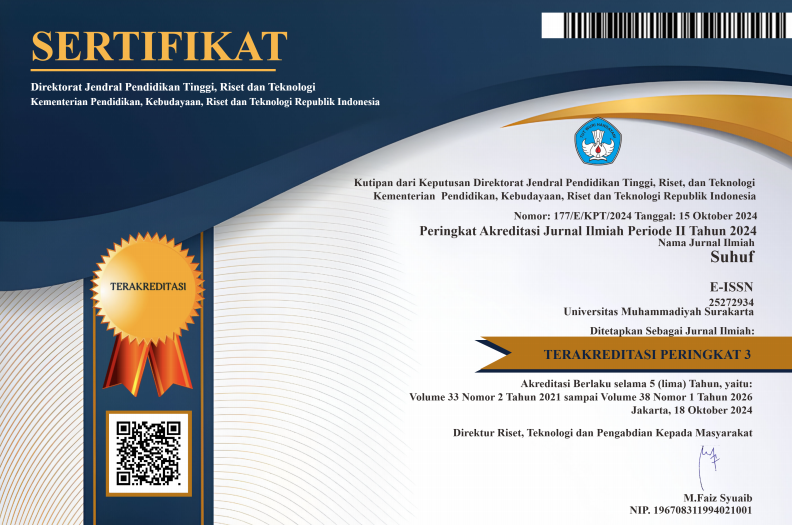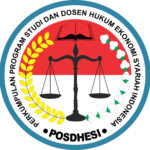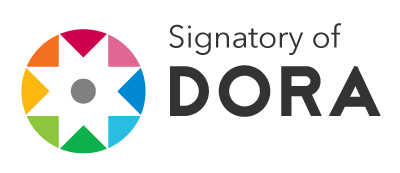Examining the Digital Revolution in Religious Education: A Bibliometric Exploration of Crises, Opportunities, and the Future of Research 2009-2025
Keywords:
Digital Technology, Religious learning, Online learning, Educational technology, Innovation in educationAbstract
This study uses bibliometric analysis to explore research on digital technology–based religious learning from Scopus-indexed publications between 2009 and 2025. The growth of technology, accessibility of digital devices, and learning innovations have driven increasing research output, while challenges such as low digital literacy, technological barriers, and online misinformation remain key issues. By analyzing 133 English-language journal articles with Scopus Analyzer, R, RStudio, and VOSviewer, this study identifies research trends, effectiveness, and challenges in integrating digital technology into religious education. Results show a significant rise in publications from 2019 to 2025, indicating growing academic and practical interest. Indonesia contributed the most publications, with Malaysia showing strong international collaboration. Thematic mapping revealed key clusters such as digital transformation, challenges, and machine learning, reflecting emerging directions and innovation potential in technology-based religious learning. This study highlights opportunities for future research to enhance collaboration, promote innovation in digital religious education, and serve as a reference for ongoing studies in this increasingly vital field.
Downloads
References
[1] K. Oktarina et al., “Meta-Analysis: The Effectiveness of Using Blended Learning on Multiple Intelligences and Student Character Education During the Covid-19 Period,” Int. J. Educ. Curric. Appl., vol. 4, no. 3, pp. 184–192, 2021, doi: https://doi.org/10.31764/ijeca.v4i3.5505.
[2] A. Noor, “Problematika pembelajaran pendidikan agama Islam di era digital,” in Prosiding Seminar Nasional Prodi PAI UMP, 2019, p. (Indonesia). [Online]. Available: https://digitallibrary.ump.ac.id/261/4/16. PROBLEMATIKA PEMBELAJARAN PENDIDIKAN AGAMA ISLAM DI ERA.pdf
[3] P. D. D. Hati, “Tradisi Lisan Sebagai Media Untuk Meningkatkan Keterampilan Berpikir Kritis Di Era Digital [oral tradition as a medium to improve critical thinking skills in the digital era],” Pedalitra Pros. Pedagog. Linguist. dan Sastra, vol. 4, no. 1, pp. 167–177, (Indonesia), 2024, [Online]. Available: https://ojs.mahadewa.ac.id/index.php/pedalitra/article/view/4182
[4] A. W. Prawira, A. Mahelvi, and B. Mufidah, “Digital Media in Religious Education : Challenges and Opportunities,” Green Philos. Int. J. Relig. Educ. Philos., vol. 1, no. 2, pp. 9–15, 2024, [Online]. Available: https://share.google/3aNMYmF8yyXUES8I1
[5] Y. M. Saputro, N. L. Inayati, and M. Ali, “Analysis of Pedagogical and Professional Competence in Utilizing Technological Pedagogical Content Knowledge (TPACK) of Islamic Education Teachers,” in Proceedings of the International Conference on Islamic and Muhammadiyah Studies (ICIMS 2023), 2024, pp. 749–764. doi: https://doi.org/10.2991/978-2-38476-102-9_65.
[6] I. F. Hasanah, U. Hasanah, S. S. Suryawati, and S. Riyadi, “New Approaches in Islamic Religious Education: Integrating Technology and Student Learning Independence,” Attanwir J. Keislam. Dan Pendidik., vol. 15, no. 2, pp. 127–138, 2024, doi: https://doi.org/10.47352/3032-503x.75.
[7] S. Wahyuni, “Efektivitas Penggunaan Media Digital dalam Pembelajaran Pendidikan Agama Islam di Era Revolusi Industri 4.0 [The Effectiveness of the Use of Digital Media in Islamic Religious Education Learning in the Era of the Industrial Revolution 4.0],” Edukatif, vol. 3, no. 1 SE-Articles, pp. 46–52, (Indonesia), Jan. 2025, [Online]. Available: https://ejournal.edutechjaya.com/index.php/edukatif/article/view/1290
[8] N. Naimi, N. Nursakinah, M. S. Sitepu, and J. M. Sitepu, “Transformasi Pembelajaran Pendidikan Agama Islam di Era Digital: Sebuah Kajian Pustaka [The Transformation of Islamic Religious Education Learning in the Digital Era: A Literature Review],” WASPADA (Jurnal Wawasan Pengemb. Pendidikan), vol. 13, no. 1, pp. 105, (Indonesia), Apr. 2025, doi: https://doi.org/10.61689/waspada.v13i1.724.
[9] A. Prasetyo and N. Fitriani, “Integrasi teknologi digital dalam pembelajaran Pendidikan Agama Islam [Integration of digital technology in Islamic Religious Education learning],” J. Pendidik. Islam, vol. 7, no. 2, pp. 145–158, (Indonesia), 2020, doi: https://doi.org/10.15575/jpi.v7i2.7321.
[10] Achmad Faqihuddin, “Media Pembelajaran PAI: Definisi, Sejarah, Ragam dan Model Pengembangan [PAI Learning Media: Definition, History, Variety and Development Model],” Idarotuna J. Manaj. Pendidik. Islam, vol. 1, no. 1, pp. 1–15, (Indonesia), May 2024, doi: 10.29313/idarotuna.v1i1.3780.
[11] Irwansyah Suwahyu and Amri Rahman, “Pemanfaatan Media Daring Pada Pembelajaran PAI di Masa Pandemi Covid 19 [The Utilization of Online Media in PAI Learning during the Covid 19 Pandemic],” Inf. Technol. Educ. J., vol. 1, no. 1, pp. 110–115, (Indonesia), Jan. 2022, doi: https://doi.org/10.59562/intec.v1i1.225.
[12] E. Rohmiati, “The Use of Digital Media in Learning Islamic Religious Education: Opportunities and Challenges,” Urwatul Wutsqo J. Stud. Kependidikan dan Keislam., vol. 14, no. 1, pp. 33–45, Mar. 2025, doi: https://doi.org/10.54437/urwatulwutsqo.v14i1.1952.
[13] M. F. Hirzulloh and T. A. Annadhif, “Islamic Education in the Era of Industrial Revolution 4.0 and the Utilization of Digital Technology in the Teaching and Learning Process,” J. Iqra’ Kaji. Ilmu Pendidik., vol. 9, no. 2, pp. 409–437, 2024, [Online]. Available: https://journal.iaimnumetrolampung.ac.id/index.php/ji/
[14] S. Z. B. Abas and Supi’ah, “Integrasi Teknologi Digital dalam Pengembangan Sumber Belajar PAI yang Kontekstual dan Relevan [Integration of Digital Technology in the Development of Contextual and Relevant PAI Learning Resources],” At-Tarbiyah J. Penelit. dan Pendidik. Agama Islam, vol. 2, no. 2 SE-Artikel, pp. 391–402, (Indonesia), 2025, [Online]. Available: https://journal.staittd.ac.id/index.php/at/article/view/395
[15] N. E. M Sholeh, “Integrasi Teknologi Dalam Manajemen Pendidikan Islam: Meningkatkan Kinerja Guru Di Era Digital Integration of Technology in Islamic Education Management: Improving Teacher Performance in the Digital Era],” J. Tinta, vol. 5, no. 2, pp. 104–126, (Indonesia), 2023, [Online]. Available: https://share.google/Mc9VxzTuCfk3NQBND
[16] M. Azhari, P. R. Syafrayani, and M. Rahman, “The Role of Digital Platforms in Islamic Education: Opportunities and Challenges,” in Proceeding International Seminar of Islamic Studies, 2025, pp. 2124–2130. doi: https://doi.org/10.3059/insis.v0i0.21721.
[17] R. Rifah, M. Jailani, and M. Huda, “Artificial Intelligence (AI): An opportunity and challenge for achieving success in Islamic education in the era of digital transformation,” Suhuf Int. J. Islam. Stud., vol. 36, no. 2, 2024, doi: https://doi.org/10.23917/suhuf.v36i2.6273.
[18] L. Susanti, M. F. Al Khoiron, A. Nurhuda, and M. Al Fajri, “The Reality of Tarbiyah, Ta’lim, and Ta’dib in Islamic Education,” SUHUF, vol. 35, no. 2, pp. 11–19, Nov. 2023, doi: https://doi.org/10.23917/suhuf.v35i2.22964.
[19] A. Zain, “Al-Qur’an Kitab Induk Sumber Ilmu Pengetahuan Dan Teknologi [The Qur’an is the main source of science and technology],” Pancawahana J. Stud. Islam, vol. 12, no. 1, pp. 1–5, (Indonesia), 2017, [Online]. Available: https://d1wqtxts1xzle7.cloudfront.net/94070485/234800360-libre.pdf?1668186424=&response-content-disposition=inline%3B+filename%3DAl_Qur_An_Kitab_Induk_Sumber_Ilmu_Penget.pdf&Expires=1762949033&Signature=NkiIuPofELAvUnSHjaN2NOYAmFZV9uaABgsAwy7Z0OlZiQ9lCF3D
[20] R. Kumar, “Bibliometric Analysis: Comprehensive Insights into Tools, Techniques, Applications, and Solutions for Research Excellence,” Spectr. Eng. Manag. Sci., vol. 3, no. 1, pp. 45–62, Jan. 2025, doi: https://doi.org/10.31181/sems31202535k.
[21] S. F. Tamami, F. Q. A. Tamami, M. Z. Azani, M. S. Aprianto, S. Husein, and A. Q. Tamami, “Maping The Development Of Critical Thinking In Islamic Education Using Bibliometric Analysis,” J. Tarb., vol. 30, no. 2, p. 284, Dec. 2023, doi: https://doi.org/10.30829/tar.v30i2.3053.
[22] A. D. Aprillia Haya, M. Z. Azani, M. S. Apriantoro, and I. Ikhwanuddin, “Analysis Muslim Personality Formation Through Islamic Education: In Bibliometric Inquiry,” Muaddib Stud. Kependidikan dan Keislam., vol. 13, no. 2, pp. 101–114, 2023, doi: https://doi.org/10.24269/muaddib.v13i2.7929.
[23] Azhar, “Transformasi Digital Dalam Pembelajaran Pendidikan Agama Islam Di Era Society 5.0 [Problems of learning Islamic religious education in the digital era],” AL-KARIM J. Islam. Educ. Res., vol. 2, no. 4 SE-Articles, pp. 268–278, (Indonesia), Oct. 2024, [Online]. Available: https://journal.institercom-edu.org/index.php/alkarim/article/view/973
[24] Septiani Selly Susanti et al., “Innovative Digital Media in Islamic Religious Education Learning,” J. Pendidik. agama Islam, vol. 21, no. 1, pp. 40–59, Jun. 2024, doi: https://doi.org/10.14421/jpai.v21i1.7553.
[25] A. K. P. Nasution, A. Ansor, and M. Miswar, “Penggunaan Media Sosial dalam Pendidikan Islam: Manfaat dan Tantangan [The Use of Social Media in Islamic Education: Benefits and Challenges],” J. Multicult. Educ. Soc. Stud., vol. 1, no. 1, pp. 38–45, (Indonesia), 2024, [Online]. Available: https://www.jurnal-assalam.org/index.php/JOMESS/article/view/819
Downloads
Submitted
Accepted
Published
How to Cite
Issue
Section
License
Copyright (c) 2025 Inatsa Zulfa Nabila, Nurul Latifatul Inayati, Silvani Yuzarni, Muhammad Fathi Salim

This work is licensed under a Creative Commons Attribution 4.0 International License.


















